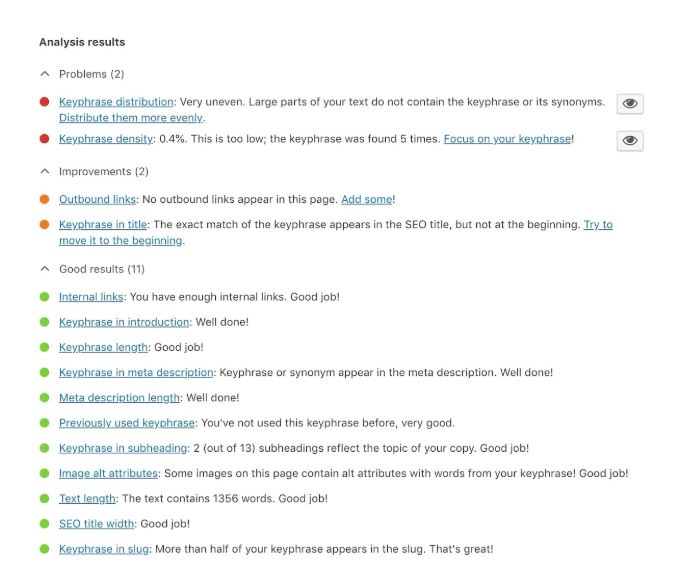WordCamp Philly is grateful for the support of our sponsors. Some of them are contributing blog posts on a variety of topics that members of the WordPress Community may find useful. This contribution is from Yoast.

As with all writing, writing blog posts requires skill. To keep your reader interested, you should think about the structure of your piece and write appealing articles. You can help your readers grasp the core concept of a post by providing headings, subheadings and clear paragraphs. If people understand and like an article, they will be much more inclined to link, share and tweet about it – and that will increase your rankings. So, if you want to improve your rankings, improve your writing skills. Start with these tips on how to write an SEO-friendly blog post!
For some, writing for SEO purposes and writing to attract and captivate your audience could seem like two conflicting goals. I totally disagree. Indeed, if you want a readable and SEO-friendly blog post, the words you want to be found for should be in a very prominent place. But, over-using keywords severely hampers the readability of your text, which you definitely don’t want to do.
This post provides tips on writing blog posts that are both readable and SEO-friendly. These two goals should always go hand in hand.
Master SEO copywriting; write content that ranks! In our SEO copywriting training we teach you the skills you need to create copy that visitors and search engines love!
Before you start writing: keyword research
Before you can start writing, you have to do keyword research. If you want to dominate the search results, you’ll just have to figure out which words your audience actually searches for. These are the topics you should write about and the words you should use in your text.
Now, let’s start with some writing tips!
Key writing tips for good blog posts
Above all, your blog post has to be a good piece of writing! When starting a new blog post, many bloggers just start writing, typing whatever comes into their heads. While this may work for some people who have natural writing talents, others may need some help. Personally, I always follow these ‘rules’ when blogging.
1. Think before you write!
Think carefully about the message of your piece. What do you want to tell your readers or which central question do you want to answer? What’s the purpose of your article? And what do you want your readers to do at the end of the page? Write down the answers to these questions before you begin.
2. Devise a structure for your blog post
Start your post by creating a clear structure. Every post should have:
- some sort of introduction (in which you introduce your topic);
- a body (in which the main message is written);
- a conclusion (which should summarize the most important ideas or draw a conclusion).
Write down what you want to say in all three sections. You now have a kind of summary of your post. Now the real writing can begin.
3. Use paragraphs
Everybody uses paragraphs, but not everybody uses them well. Don’t start each new sentence on a new line, just because it looks nice. There should be a logical reason for starting a new paragraph. Each paragraph should have its own idea or subject. Ask yourself what the main idea of each paragraph is. You should be able to summarize that main idea in only one sentence. If you need more sentences, you simply need to use more paragraphs.
4. Use headings
Headings structure the whole page, so use them. They’re important not just for readability, but for SEO as well. Headings also help Google to grasp the main topics of a long post and therefore can help in your ranking. If you want people to find their way through your articles, you should use subheadings to lead people, help them scan your page, and clarify the structure of your articles. Make sure you use your keywords in some of the subheadings, but not in each and every one of them, as it will make the text clunky and unnatural, which will put people off reading further.
5. Use signal words
Signal words help people to scan through your text and grasp the main ideas. Let’s say, for example, that there are three reasons for people to buy your product. You should use signal words like: ‘first of all’; ‘secondly’ and ‘finally’. Also, words like ‘nevertheless’, ‘surely’ and ‘indeed’ give a clear signal to your readers. Readers will instantly get that a conclusion will follow after words like ‘consequently’, ’so’ or ‘for this reason’. Signal words are therefore very important to add structure to your text.
6. Let other people read your post
Before publishing your post, let someone else read it first. Ask them whether they understand the main concept of your post and invite them to correct any typos and grammatical errors.
7. Optimize the length of your article
Make sure your articles have a minimum of 300 words. Google likes long articles, however, if your article is too long – and not so easy to read – it might scare users away. Only try writing long articles when you know you’re a skilled writer. Check out this article if you want to know: “how long should my article be“. And don’t forget to use your focus keyphrase now and then!
8. Link to previous content
If you’ve already written content on the same topic as your current post, don’t forget to link these posts together. It will make your post stronger because you show some authority on the subject. As well as that, your link structure is also important for your Google rank. And of course, readers may be interested in reading these related posts too. If you want to read more about this you should read about internal linking for SEO.
9. Add content regularly
Regularly adding new blog posts to your website tells Google that your website is alive. If it’s not an active website, Google will crawl it less often, and this might negatively affect your rankings. But don’t just post for the sake of posting. Make sure you post high quality content: informative, well-written articles that fit people’s search intent.
10. Use our Yoast SEO plugin
The analysis tool in our Yoast SEO plugin helps you write SEO-friendly and readable blog posts. Start by choosing your focus keyword because this is the most important search term you want people to find this particular page for. Then it runs all kinds of checks to see whether your post is optimized well:
- Our plugin checks your post to see whether you have used the keyphrase in the right places, like your copy, title, meta description, alt text and URL. Yoast SEO Premium will also recognize different word forms of your keyphrase.
- It checks the readability of your text: Are your sentences or paragraphs too long? Do you use transition words?
- It checks for internal and external links and images in the article. Yoast SEO Premium even provides suggestions for links to related articles on your site.
- It calculates how often you use your keyphrase throughout your text: not enough or too often? In Premium it also checks if you’ve distributed your keyphrase or its synonyms well.
- It also checks if other pages on your website use the same focus keyword, to prevent you from competing with yourself.
If you write a relatively SEO-friendly blog post (based on the aspects discussed above) the plugin will indicate this with a green bullet. Pages with green bullets will help you improve the ranking of the pages on your website.
Note that not every dot has to be green for the overall SEO score to be “good”. For instance, these are the results of this post, which does have a “good” score:

If you want to know how to use the SEO and readability analysis of Yoast SEO exactly, read this post on how to use Yoast SEO well.
Conclusion
The days when a few SEO tricks were enough to get your website to rank well in Google are long gone. Nowadays, quality content is king. And good content also leads to more links, shares, tweets and return visitors to your website. Of course, there are always other things you can do to maximize the SEO friendliness of your post, but most importantly, just write very, very good posts! Still not sure if your blog post is ready to publish? Take a look at this checklist and make sure your good to go!
